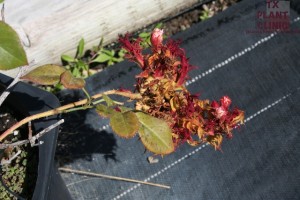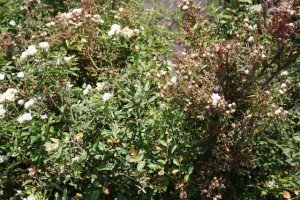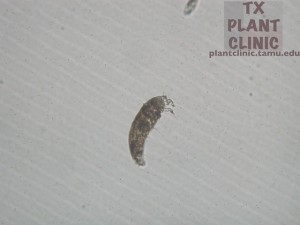*FOR UPDATED ROSE ROSETTE INFORMATION – Please visit http://roserosette.org
See how much we have gained in learning about this disease since this was posted in 2011, the pathogen that causes this disease and the vector that transmit this disease…and see how much we still do not know about this disease system*
Recently there was quite a bit of “chatter” about rose rosette. This year, we have heard of reports from parts of Texas, Ohio, Michigan, Indiana, Tennessee and some other states. It seems that this disease is becoming more prevalent especially on knockout roses. But is it because that more folks are planting roses, in particular knock-out roses? Nonetheless, this is quite an interesting disease that we know little about.
Anyhow, what is rose rosette? This is a disease of roses that was described in the 1940s and manifest itself with “witches-broom” symptoms. Usually, the infected rose branch/cane will also be extra thorny. Just recently, research from a group lead by researchers at University of Arkansas reported on identifying a virus that is believed to be causal agent of this disease (Journal of General Virology 2011 92:1727-1732) [article online limited to subscribers]. Yet in another paper published in 2010, there were suggestions that this disease may be caused by phytoplasmas (see http://www.akademiai.com/content/g3j4053660j33787/ ) But over the years, it was believed that rose rosette was caused by some kind of virus. The story is not all said and done because no one has been able to show conclusively the cause for this disease. To prove that a pathogen is the disease causal agent conclusively, one must satisfy Koch’s postulate. In simple terms, it means that one must isolate the causal agent from a diseased plant. Infect a healthy plant with the pathogen and get similar symptoms as in the diseased plants. Isolate the pathogen from the newly infected plant and demonstrate that it is the same organism as the one originally isolated.
So what can you do if you find it in your yard? Not much. Here are a few suggestions:
1. Prune out the cane/branches when first spot rose rosette symptoms….and hope that it has not spread.
2. Rose rosette virus is believe to be transmitted by eriophyte mites (this is a really tiny mite). Some miticides/insecticide such as abamectin (Avid), cabaryl (Sevin) and/or petroleum-based horticultural oils. The catch is that you need good complete coverage and this is hard to do against these mites that hide in some very difficult to access places on the plant.
3. The best solution that have been recommended so far is the removal and complete destruction of an infected rose plant.







Pingback: Rose rosette disease transmitted by a mite « Insects in the City